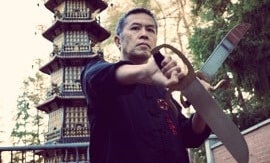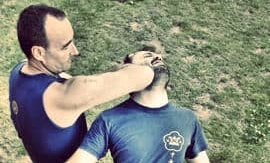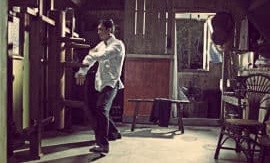
AS GRANDMASTER IP MAN’S MOST SENIOR STUDENT IN HONG KONG, THERE IS NO QUESTION THAT SIFU LEUNG SHEUNG WAS ONE OF THE MOST RESPECTED IN HIS DAY. AFTER ALL, HE WAS NOT ONLY SENIOR TO MOST OF IP MAN’S STUDENTS IN HONG KONG, BUT HE WAS SENIOR TO ALL OF THEM! THEY ALL LOOKED UP TO HIM DUE TO HIS SUPERIOR SKILL, GUIDANCE, ADVICE, MENTORSHIP, INSIGHT AND KNOWLEDGE.
However, would you even be practising Wing Chun today if it weren’t for Leung Sheung? Would you even know the name of the art? Without the help and dedication of Sifu Leung Sheung, would Ip Man have ever even been able to get off the ground as a teacher?
Although these questions and arguments cannot be answered with any real certainty, once we know the facts, we can all agree that Sifu Leung Sheung played one of the most crucial roles in the early development of Wing Chun in Hong Kong.
Briefly, Leung Sheung is too important to be overlooked. So, why don’t we hear more about him? As the senior-most student of Ip Man, didn’t he pave the way for every other student who came along after him? Therefore, he must have gotten much one-on-one time with his Sifu. What was his relationship like with Ip Man’s other students? And how was he as a teacher?
When Ip Man moved to Hong Kong, he was down and out. He had no job, knew very few people, and had no place to stay. It was Leung Sheung who secured Ip Man a job and a place to live. As the general secretary of the newly formed Hong Kong Restaurant Workers Union, Leung Sheung had a good deal of influence and pull with the organisation. When a martial arts teaching position became available, Leung Sheung, who was known for his professionalism and ability to communicate, nominated Ip Man for the job.
This is important to note because Ip Man could now earn a living teaching Wing Chun and had found a place to stay. He no longer had to look elsewhere for a job. As a result, he could now dedicate his time to teaching Wing Chun. Marking Ip Man’s journey as a full-time Wing Chun teacher, the art was able to get the dedication it needed to become known. It was Leung Sheung who changed Ip Man’s entire life. It can be logically assumed that because of this, Ip Man thanked Leung Sheung by pouring as much of his knowledge into him as he could.
As a testament to his nature, Leung Sheung also passed on the opportunity to take the same job Ip Man accepted. It was actually Leung Sheung who was the front-runner for the position. His fellow Union members nominated him knowing he had trained several traditional Chinese martial arts starting when he was young. His Gung Fu experience included such styles as Bak Mei, Choy Li Fut and Southern Dragon Style. However, rather than take the job, Leung Sheung instead nominated Ip Man. With this, he fully emptied his cup—no easy task for an experienced martial artist. Although he had extensive knowledge in these other Gung Fu systems and students asking to learn from him, he instead let go of all his previous martial arts training to submit to his new Gung Fu path and study seriously under Ip Man. This act was an example of Leung Sheung’s humble, giving nature.
As a Wing Chun practitioner, Leung Sheung’s Gung Fu brothers knew him for his unquestionable talent. Based on ability alone, he may have very well been one of the most respected of Ip Man’s students. Due to his grasp of the system and ability, it was commonly said those who learned Chi Sau from him were certain to develop good skill. Yet, Leung Sheung never became famous. All too often, his name gets left out of discussions of the notable students of Ip Man.
So, why is one of Ip Man’s most respected students so overlooked today?
Leung Sheung started Wing Chun later in life and passed away way too early. Much of who Leung Sheung was and his legacy must be learned through articles such as this one and asking questions of the select few still alive who knew him.
Leung Sheung didn’t find Ip Man and begin training Wing Chun until his thirties. Most of Ip Man’s students began much earlier. Compared to other early students of Ip Man, Leung Sheung was 15 years older than Chu Shong Tin and almost 20 years older than Wong Shun Leung. In contrast to Ip Man’s most famous student, Leung Sheung was 22 years older than Bruce Lee.
There are no videos of Leung Sheung in action—not one! Therefore, we have no way of seeing him move, in action. Nearly every other student of Ip Man has some kind of video out there. Video offers so much to those of us who care to pay attention. However, when it comes to Leung Sheung, we only have a few still shots of him in action with Lok Yiu.
Additionally, Leung Sheung was an immensely humble man who was overly modest about his Wing Chun abilities. As a student and teacher, he consistently promoted Ip Man’s abilities instead of his own. Despite being one of the few students that Ip Man ever encouraged to teach publicly, Leung Sheung kept a very low profile.
He never once advertised his school. One of his most famous sayings was, “If you find me, you are lucky.” Was this due to his loyalty to Ip Man and desire to elevate Ip Man’s reputation?
Leung Sheung was also very selective in whom he chose to teach. His Wing Chun teaching philosophy was to visualise students as driftwood. Picturing himself living along a river, he imagined driftwood washing up in front of his home. At times, he would look at the driftwood and find a piece that he found interesting. He would continue to collect driftwood and eventually pick one piece that he found interesting enough to begin to shape. As he would learn, some driftwood could be shaped and some could not, either due to faults or imperfections. Once Leung Sheung determined that a student was worthy of his teachings, he became highly demanding of them.
Insight into what Leung Sheung viewed as important in Wing Chun can be found through his teachings. He was a stickler for what he believed to be good Wing Chun. According to his student, Dr. Jack Ling, Leung Sheung heavily emphasised key points of body alignment when teaching his students Siu Nim Tau. These included turning the feet and knees in while dropping them down to their lowest possible point without altering posture. The head should be up and level with the eyes pointing forward. The back must be straight, and the elbow must remain turned in front of the body at least a fist-width away. The forearm should remain extended, relaxed, flat and parallel to the ground. The shoulders must not lift in any way and should remain relaxed and natural. Leung Sheung also focused on developing a heavy sunken elbow, something he referred to as under elbow strength. The breath must be relaxed and low, sinking into the diaphragm.
Unfortunately, due to declining health for nearly a decade, after having a kidney stone removed, Leung Sheung died at the relatively young age of 60. Despite being recognised as one of the best Wing Chun practitioners that Ip Man ever produced, Leung Sheung is arguably one of the most overlooked masters in Wing Chun history. Despite leaving us way too soon, Leung Sheung must be acknowledged not only for his great Wing Chun ability but also for the invaluable role he played in the advancement of Wing Chun as a whole.



















